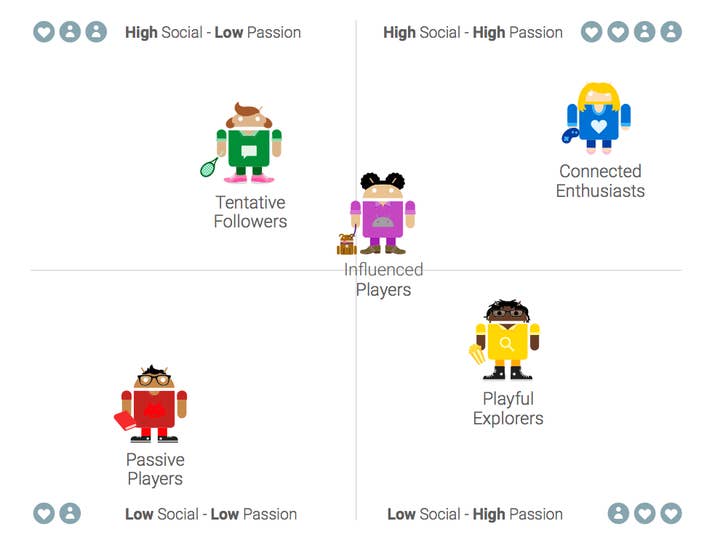Who plays mobile games?
Google Play's UX researcher Allen Bevans identifies various 'player segments' and how they engage with smartphones
The amazing growth of mobile games across the world means more and more people engage with gaming experiences previously limited to users of other platforms such as PCs and consoles.
This expansion means the characteristics, needs and motivations of those playing games are more diverse. While this diversification of players is an amazing opportunity, it also can be a challenge. In order to build games that excite and engage such a diverse audience, developers need to build deep and meaningful insights about their current and potential customers.

To help build such insights, Google Play commissioned a research study to understand differences and similarities in the needs and behaviors of mobile game players across the world. Initially we ran this research for internal purposes, but we believe our findings are of value to the wider community of mobile game developers. The research report can be found here.
We used to think 'gamers', now we think 'players'
It can be easy to think of people who play games belonging to one of two extreme groups - the 'hardcore' gamers living and breathing complex highly skilled games, and the 'casual' gamers playing low skill, non challenging games. These extremes are also associated with a range of demographic assumptions and stereotypes, like "hardcore" gamers being young and male, and "casual" gamers being old and female. The reality is a majority of players fall somewhere between these two extremes along the game playing spectrum.
The role of games in a player's life and their social behavior drive the most similarities and differences
Our first challenge when considering the spectrum of players was to create some form of order. How were these millions of players similar or different in terms of their attitudes, needs and behaviors when it came to mobile games?
In our survey of over 20,000 mobile game players across eight markets, we asked a series of questions about different aspects of their game playing: how they find out about games, what about games are important to them, how and when they play, how gaming fits into their lives, etc. We found the questions that truly differentiated groups of players from each other centered around their social behaviors and their passion for games.
Examples of social behaviors include both the influence of others in game discovery and choice, as well as playing against others, or as part of a community or alliance. Passion for games includes time spent playing, the centrality of gaming to their identity and fan-like behavior such as purchasing branded merchandise.
We identified five distinct segments of players based on these dimensions:

These five player segments also have different behaviors which can be used to understand gaming preferences and motivations, and we have analysed the findings into the four following key insights:
1. Demographics are not the primary drivers of difference
Once we identified the five segments based on these dimensions, we started to learn more about them in terms of who they are and how they behave. It is really important to highlight that while there are demographic differences between these segments, these are not the primary drivers of segment differences. Too often segmentations like this primarily differentiate segments in terms of life stage or gender, which can hide key commonalities and differences across dimensions that really matter. While there are slightly more younger 'connected enthusiasts', or older 'passive players', the dominant age profile for both segments is between 26 and 45 years old. Likewise, there is only a slight male bias (just over 50%) for 'connected enthusiasts' and 'playful explorers'.
2. The player segments use a range of channels and influencers to discover games
'Connected enthusiasts' use the most channels to discover new games, but nearly all their main channels involve other people - either in real life or online, e.g. YouTube. They are also the most likely to react to in-app advertising. 'Playful explorers' are less socially dependent, with their main sources of game discovery coming from Play Store top charts, YouTube, in-app ads and game ratings. As expected, it's all about influence from others for 'influenced players' and 'tentative followers' - either their friends, seeing someone else play a game, or watching someone play on Youtube. 'Passive players' are more influenced by top charts and in-app ads, as well as "other" sources of discovery - sources that don't fit into the pre-defined categories in the segmentation surveys.
3. Player segment does not equal one genre
When we asked players about the types of games they play, we saw similarities across all the segments. Puzzle games are universally appealing, as well as Strategy (except for the 'passive players'). We did see some specific clusters of game types for certain segments.
'Connected enthusiasts' play nearly every genre and are less likely to skew towards any one in particular. However, 'playful explorers' skew more towards action and adventure games. 'Influenced players' are big puzzle fans, but also enjoy adventure and strategy. 'Tentative followers' enjoy card, trivia and word games, while 'passive players' are all about puzzles and card games.
4. Motivators of engagement go beyond just relaxation and boredom
Relaxation and boredom relief are universal motivators to keep people playing mobile games. However, we see some other more actionable drivers of engagement that vary across segments. In particular, the 'connected enthusiasts' are all about making progress, testing their skills (both personally and with others) and 'rewarding' themselves with the pleasure of game play. 'Playful explorers' and 'influenced players' also see playing games and making progress as a reward, but are less focussed on testing skills compared to others. 'Tentative followers' and 'passive players' are less likely to focus on the pleasure of game playing.
Implication for developers
- Consider the various gaming needs of your players. Unless your game is highly targeted towards a specific demographic group, don't fall for demographic stereotypes. Instead, think about the different gaming needs being met by your game and the key experiences your game provides.
- Take player differences into account when designing your game or adding new features:
- Be specific: Is this feature for a certain segment of players, or all players in general?
- Be informed: Get feedback from the right segments of players.
- Be concrete: Articulate how a feature will change specific aspects of these players' experience, and why that is important to them.
- Tailor your customer acquisition strategy. Use the best marketing channels to reach each desired player segment. Players of all kinds discover new games in many ways, but if you're building a game for a specific kind of player, you should optimize your strategy to emphasize the channels they engage with most.
- Tailor engagement strategies to motivate your target player segment(s). 'Connected enthusiasts' love leaderboards and challenging their community while 'playful explorers' are more interested in personal progress. Use the game content that is the most meaningful to your players to help them discover and engage with your game.
Have a read of the full report and let us know what you think. Do these player segments ring true? What do you find surprising? What more do you want to know about these segments?